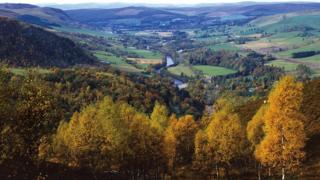Fears of A9 dualling impact on historic sites
 Image copyright
Getty Images
Image copyright
Getty Images
Campaigners are calling for a review of the planning process being used to build a dual carriageway link on the A9 between Inverness and Perth.
They claim the current arrangements do not offer adequate protection to the historic and natural environment.
The site of 1689's Battle of Killiecrankie in Perthshire and the Insh Marshes near Kingussie are areas of concern to campaigners.
The Scottish government said it was tackling objections to the £3bn scheme.
To be completed in 2025, the project involves the upgrading of 12 sections of single carriageway to dual carriageway.
Campaign group Killiecrankie1689 says the construction of a new stretch of road at Killiecrankie would see 30 million metric tonnes of construction material laid across the site of the battle's main fighting.
The battle took place on 27 July 1689 between a Jacobite army under the command of John Graham of Claverhouse, 1st Viscount of Dundee, 'Bonnie Dundee', and a government army commanded by General Hugh Mackay.
Both armies were attempting to reach Blair Atholl to use it as a base for future operations.
The Jacobites are thought to have lost 800 men, with around 2,000 casualties among the government troops.
George MacLean, of Killiecrankie1689, said natural terraces which the Jacobites ran down to attack the government army would be lost to a new stretch of A9.
He said: "That's the area that is going to be destroyed with the road coming through.
"The community here in Killiecrankie is very worried about the plans for the A9 road from Killiecrankie to Glengarry. It is going to cut through a historic battlefield."
Natural habitat
Killiecrankie1689 is calling for a review of the construction project's planning process.
Ruraidh Ormiston, a farmer in the Cairngorms involved in conserving parts of his land for wildlife, supports the idea of a review.
The A9 already runs through the Insh Marches between Kingussie and Kincraig, but the planned new wider dual carriageway would involve more of the natural habitat.
Mr Ormiston said: "We've had a lot of roadshows and got nice graphics, but not a lot of dialogue.
"I am not sure people are consulted enough on what things are going to be affected."
The Scottish government said the upgrading of the A9 was one of the biggest transport infrastructure projects in Scotland's history.
A new dual carriageway between Kincraig and Dalraddy has been open since September 2017, and construction work has started on a section of road between Luncarty to Pass of Birnam. It is due to be completed in 2021.
A Scottish government spokesman said: "At the same time, design work on the A9 dualling programme continues at pace with eight of the nine remaining dualling schemes being designed now at draft order stage.
"We are working to resolve any objections to these schemes but for any scheme where all objections can't be resolved, there is likely to be a need to hold a Public Local Inquiry.
"Across the programme, we are also carrying out vital ground investigations to help inform this design work."
He added: "The remaining scheme between Pass of Birnam to Tay Crossing has been subject to a co-creative process in which the community identified their preferred option.
"Transport Scotland is now taking forward further design and assessment work and will consult locally before submitting to Scottish Ministers for consideration."